Phaseolus vulgaris
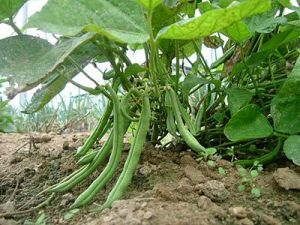
There are two types of bean : dwarf varieties, varieties, which do not need to be staked, and climbing climbing varieties, which are longer-lasting and allow for more ergonomic harvesting.
It's a crop that's valued and appreciated by appreciated by customers. However, beware of harvesting time, which often determines the profitability of this crop.
Preparing the soil
Beans have a good root system that fixes atmosphericnitrogenfrom the from the flowering stage. At the beginning of the season, covering the crop with a tarpaulin limits weed growth. weed growth.
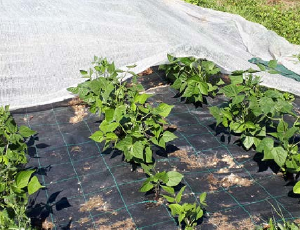
Beans are grown on tarpaulin or organic mulch.
straw is added to the greenhouses by handto a thickness
to a thickness of 10 to 30 cm. Be careful when planting
planting at the start of the season, because in the event of frost, the straw
prevents the warmth of the soil from protecting the plants. Prefer
a late mulch for better plant recovery.
Planting
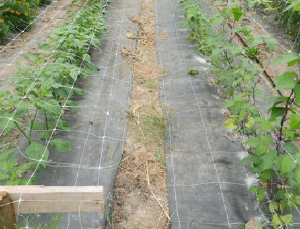
For direct sowing ofbush beans, rows spaced at 40 cm apart in the straw. Sowing is carried out in 3 to 7 seeds every 25 cm. For pole beans the spacing to be respected is 12 cm on the row and 1 metre between rows to make picking easier. picking.
Twine or netting, preferably biodegradable, is used for trellising.
nets, preferably biodegradable, to leave the residues in place
at the end of the crop. Outdoor structures made of bamboo or concrete reinforcing bars can also be erected, with strings attached to allow the beans to climb.
Tip : The pole bean is interesting for its easy harvesting and long harvesting period, while the bush bean is interesting for its earliness.
Cultivation follow-up
The bean is a fast-growing plant and is therefore quite is therefore quite competitive with weeds. Manual weeding may be necessary if weeds break through the mulch. break through the mulch. In this case, add straw straw in high-risk areas. The bean is a voluble plant that wraps easily around vertical strings, so you don't necessarily need to stake them manually.
Irrigation
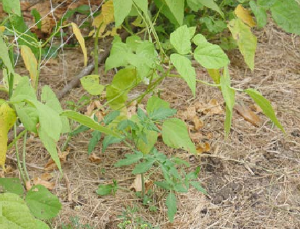
Seedling emergence does not require a lot of water. watering before sowing is recommended if the soil is too dry. Irrigation is by drip, avoiding cold water. cold water. Irrigation should be regular, adapted to the weather to the weather and in the morning.
When the weather is warm, a quick sprinkling will prevent the appearance of certain pests(red mites), as well as reducing the temperature in the greenhouse (which needs to be kept under control, as it can damage the plants).
reduce the temperature in the greenhouse (this should be kept under control as it
this can encourage fungal diseases).
More water is needed from flowering onwards. Be careful, watering in the heat can cause flowers to abort. flowers abort.
Harvesting
Harvest by hand when the beans are barely visible from the outside. are barely visible from the outside. Yields will be lower yields will be lower despite the pod's tenderness. the beans become stringier. Harvesting is carried out every 2 to 3 days to ensure that they are always at the best stage of maturity. Efficient harvesting determines the profitability of the crop (at least 5 kg/h). Beware of wet pods which keep less well.
Storage
Beans do not keep well for long, so it is best to sellthem fresh. They are best sold fresh. They will keep for around 8 to 10 days at a temperature of between 5 and 10°C and a humidity level of around 95%.
Pests and diseases
- The main problems are fungal diseases caused by overcrowding and poor ventilation. Be careful not to over-water and ensure that the crop is well aerated.
- Insects such as aphids and mites can colonise the crop without necessarily causing major problems.
Possible ITK variations
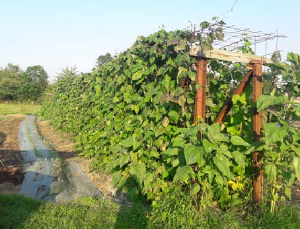
It is also possible to raise plants in plugs for later replanting.
to be replanted later. This makes it possible to early, especially at the start of the season when temperatures are not ideal for sowing in the ground. This also reduces the risk of loss to rodents. Sowing is carried out in the nursery in honeycomb trays or in clods for transplanting at the two-leaf stage, i.e. around 1 month later.
Photo gallery
Sources
- This page is based on the guide Introduction au maraîchage sol vivant from MSV Normandie.
